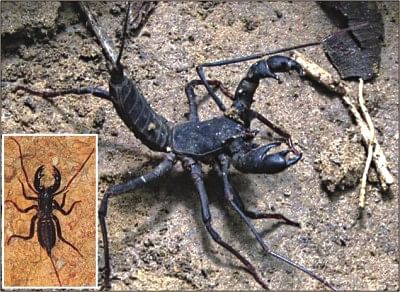Whip scorpions seen nearly 100 years after!

Whip scorpion, one believed to be Hypoctonus oatesii, sighted at Lawachhara and another one, Hypoctonus carmichaeli, inset, spotted in Kalenga. Photo: Courtesy
I was frantically searching for a few frogs that were likely to be hiding under the hard blocks of hilly soil, fallen logs and other materials on the floor of the Lawachhara National Park near Srimongal after a burst of monsoon rain.
The driver of a three-wheeler -- who was doubling as my field helper for the time being -- and I were the sole visitors to the park on that Saturday.
While walking along a trail, we saw a few bags of solidified cement blocks stacked one over the other. They had been lying by the side of a rainwater drainage line for ages.
I thought there could be animals hiding under those blocks.
Quickly I focused my camera on it and told the driver to lift the topmost block. As he did so I noticed a pipe-like structure, much thinner than the lead of a pencil, projecting from a hole.
On first sight, it looked like an alien. I told my companion to coax it out of its hiding place. He did so and the animal obliged for a few seconds, coming out of its hiding. It walked a few paces gaudily and then disappeared under the unturned cement block.
By that time I had taken a good look at it and also got a few shots of it.
The animal is none other than a funny-looking creature known as Whip-Scorpion, False Scorpion or Vinegarroon. It iss more related to the spider than their physical resemblance to the scorpions or Bichha or Bichchhu as it is called in Bengali.
The very absence of the sting and venom sac at the end of its tail and a different beaded flute-like tail convinced me that it was not a Bichha. However, I was not sure of its identity.
After returning to Dhaka I surfed several internet sites and checked the Asiatic Society's Fauna volume on Arachnida -- a class of invertebrates which include the largest number of animals after the Insects, with nearly 100,000 species of spiders, several thousand ticks, mites, harvestman, scorpions and about 100 species of scorpion look-alike Whip and False scorpions.
During 1900 British scientist Pocock described a species Hypoctonus oatesii based on specimens collected from Shamshernager in Sylhet. A second species of the same genus named Hypoctonus cramichaeli was named by a scientist called Gravely in 1916 and this was based on three male Whip Scorpions collected from Rangamati by a specimen collector from the Indian Museum in Calcutta who accompanied Lord Carmichael on an official tour of Chitagong Hill Tracts.
A third species Uroproctus assamensis was identified by Stoliczka in 1869 based on specimens collected from Sylhet and Assam in India.
I have recently photographed two of these three species, one from Lawachhara and the second from Kalenga Wildlife Office in the Tarap Hills in Habiganj.
I think these are the only pictures taken of the two species in Bangladesh after the Whip-scorpions were first discovered in the country in the early 1900s.
They are called whip scorpion because their tail segments or the last abdominal segments have been modified into a long whip-like tube. Moreover their appendage in front of the first leg is modified as in a scorpion or crab, which is used for crushing prey animals.
The first pair of legs of this creature is modified into sensory organs and function like the antennae of insects. So, they walk on the remaining three pairs of legs.
Also all Whip Scorpions have organs at the base of the whip that can spray a special vinegar-like chemical. These creatures are absolute night animals and always hide under dark objects during daytime.
Thus they avoid sighting by people.

 For all latest news, follow The Daily Star's Google News channel.
For all latest news, follow The Daily Star's Google News channel. 



Comments